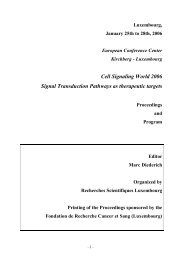Abstract book (download .pdf file) - Redox and Inflammation ...
Abstract book (download .pdf file) - Redox and Inflammation ...
Abstract book (download .pdf file) - Redox and Inflammation ...
You also want an ePaper? Increase the reach of your titles
YUMPU automatically turns print PDFs into web optimized ePapers that Google loves.
Session 3: Transcriptional control Poster 5<br />
Role of MDC1 in NF-kappaB activation by DNA double-str<strong>and</strong> breaks.<br />
Helene Sabatel, Jacques Piette <strong>and</strong> Yvette Habraken.<br />
Laboratory of Virology <strong>and</strong> Immunology, Signal Transduction Unit, GIGA-R,<br />
University of Liège, 4000 Liège, Belgium. helene.sabatel@student.ulg.ac.be,<br />
jpiette@ulg.ac.be, yvette.habraken@ulg.ac.be<br />
Many anticancer treatments, such as ionizing radiation (IR) <strong>and</strong> DNA topoisomerase I <strong>and</strong> II,<br />
induce apoptosis in tumor cells by generating DNA double str<strong>and</strong> breaks (DSB). ATM kinase,<br />
rapidly activated by DSB, orchestrates different aspects of the DNA Damage Response: cell<br />
cycle arrest, DSB repair <strong>and</strong> transcription factors activation. Both NF-kappaB <strong>and</strong> p53 are<br />
activated by DSB, controlling anti- <strong>and</strong> pro-apoptotic signals <strong>and</strong> therefore affecting cell<br />
survival <strong>and</strong> the outcome of the cancer treatment.<br />
In this work, the importance of MDC1 (Mediator DNA damage checkpoint 1) in the DNA<br />
damage signalling to NF-!B is studied. As expected, MDC1 reduction by siRNAs resulted in<br />
a smaller number of nuclear foci after IR <strong>and</strong> Camptothecin treatments. We observed that<br />
reduced MDC1 level leads to a reduction of NF-!B nuclear translocation after both<br />
treatments. NF-!B transactivation potential was assessed with two reporter systems; either a<br />
transiently transfected !B-Luc reporter plasmid or a stably integrated !B-GFP reporter. In<br />
both cases, we noticed a large reduction of the transcriptionnal activity in cells treated with<br />
siRNA-MDC1. The reduction was however less important than the one observed in cells<br />
treated with an siRNA-ATM. Mefs WT <strong>and</strong> KO for MDC1 were tested for NF-!B activation<br />
by IR <strong>and</strong> Camptothecin. However, as Mefs WT did not activate NF-!B following DNA<br />
damage we could not use this model. The effect of the deletion of different domains of MDC1<br />
is also analysed to determine by which way this protein interferes with NF-kappaB signalling<br />
pathway (foci dependent or independent manner).<br />
In summary, our data indicate that deletion of MDC1 has an impact on NF-!B activation after<br />
both IR <strong>and</strong> Camptothecin treatments contrarily to the disruption of NBS/Mre/Rad50 complex<br />
that affects only IR signalling under the tested conditions.<br />
Financial supports: IAP 6/18, Centre anti-cancéreux de l’ULg, FRS-FNRS, F.R.S.M<br />
102




